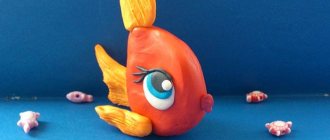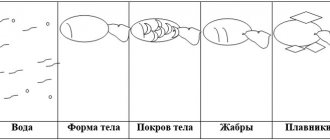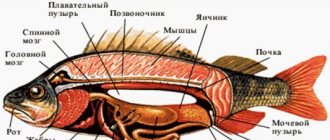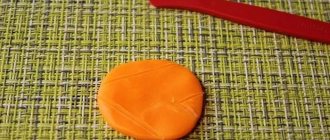Ecological fairy tale for children 5-7 years old
“The Tale of How the Golden Fish Saved the Sea” An environmental fairy tale for children aged 5-7 years.
Goal: developing an idea of the patterns in nature, that a violation of natural patterns can lead to an environmental disaster. Objectives: — carrying out preventive work to prevent pollution of water bodies; — expanding the horizons of pupils; development of oral speech; - fostering a love of nature; compassion for all living things. “The Tale of How the Golden Fish Saved the Sea” (The publication uses illustrations by I. Yesaulov)
In the underwater Kingdom of the Blue-Green State, there lived a Golden Fish.
She was very cheerful, such an entertainer that it’s hard to imagine! Either she decides to play with a ray of sunshine, or she decides to make multi-colored pyramids out of sea pebbles... I’m never bored. And the Golden Fish had friends - Medusa, Crab and Turtle. They all loved their home – the sea. After all, at the bottom of the sea they had so many interesting things: pink and bright red corals grew everywhere, as if outlandish trees, mother-of-pearl shells lay here and there, preserving their beautiful pearls. Once a year, all the shells opened their doors and showed the underwater world their wealth - pearls, and after that, having heard enough of the enthusiastic exclamations of the audience, the shells again hid the pearls in their mother-of-pearl chests for the whole year. But one morning a big disaster happened to the inhabitants of the Underwater Kingdom. The sea inhabitants were enjoying a beautiful summer morning, when a huge shadow lay on the bottom of the sea. Medusa : -What is it? What's happened?
Crab: -This is an oil tanker floating above us.
Turtle: -Oh, Crab, how smart you are! What is a tanker? And why is it called “oil”?
Crab: -And this is a ship that transports oil from one place to another. Medusa: -Oh, here it is... Well, what is it that flows out of it and spreads like a black spot, blocking the sky and the sun from us? Crab: -Oh, what a horror, but this is a leak on the ship, that is, a hole has formed somewhere - a hole from which oil is leaking. Soon we will all die! Turtle: -Don’t joke like that, Crab!.. Crab: -I’m not joking, oil is very oily, it will cover the surface of the water with a greasy film and air will stop flowing into our water. And we will all suffocate! Medusa: -What? What do we do? Crab: -I don’t know... Turtle: -But I know! On the other side of the sea there is a Pink Shell. It contains magical bacteria - tiny creatures that can eat an oil slick. This is a real treat for them! And here's another thing - today is the day when all the sea shells open their doors! Goldfish: -I’ll immediately swim for the Pink Shell, because I swim faster than all of you! And we will save our home - the sea! And the brave Golden Fish set off on a journey, with great difficulty she found that very treasured Pink Shell and brought it home! The unfortunate friends were already barely alive... They gasped for air with their tiny mouths and felt completely bad. The pink pearl released bacteria into the water and they quickly dealt with the nasty oil slick! The sun shone again, and even the clouds in the blue sky became visible to the inhabitants of the underwater Kingdom! Everyone breathed freely! And the Golden Fish was the most happy, because she helped save her such a beautiful and beloved underwater world from destruction!
After reading the fairy tale, you can ask questions:
- Why did the sea inhabitants almost die? — How did the sad events of the fairy tale make you feel? — Name the rules of behavior on reservoirs.
We recommend watching:
Ecological conversation for children of the preparatory group Ecology quiz game “Nature Experts” for children of the senior group Environmental event in the senior group. Scenario Summary of an experiment on ecology in kindergarten. Senior group
Similar articles:
Lesson summary on the topic “Reserve” in the senior group
Summary of a lesson on ecology in the senior group on the topic: Sea inhabitants
Lesson notes on ecology in the senior group of kindergarten
Conversation “Take care of the forest” for preschool children of the senior preparatory group
Lesson summary - fairy tales in the preparatory group of kindergarten
LiveInternetLiveInternet
History_By_Us_- ( Libertalia
) all posts by the author Told by
Anna Providence
Tiddalik causes a flood. (Australian folk tale). Tiddalik was the largest frog in the world. One day he drank water from all the ponds, lakes and rivers of the world. All that was left was the water in the seas. But the animals could not drink salt water, so they had to die of thirst. Luckily, Eel had an idea. He began a funny dance which made Tiddalik laugh. When his mouth opened, water flowed into ponds, lakes and rivers, and the animals were saved. Why does the crab have no head? (African folk tale). Goddess Nzambi created all animals. She started creating the Crab just before bedtime and didn't have enough time to finish it. “Come tomorrow, I will give you the head,” she said. “It takes Nzambi two days to make me, because I am a very important person,” the Crab boasted to the other animals. Nzambi heard about the crab's boasting and decided not to give him his head. The crab hid under a rock in shame. To this day, he pokes his eyes right out from under the sink, since he still has no head. Magic fish. (Scandinavian folk tale). One day a poor fisherman caught a magic fish. “Let me go, and I will do everything you wish,” said the fish. The fisherman wanted a big house, and his wish came true. He caught the magic fish again and again and made more and more wishes. And his every wish came true. But when the fisherman demanded the moon and stars, the fish decided that he was too greedy and took all his gifts. And the fisherman became poor again. How the starfish was born. (Based on a story by Donald Bisset). One day, on a dark, starry night, seven elephants decided to catch a falling star. They went to the top of the sea cliff and, climbing one on top of the other, formed a tower. The baby elephant, who was at the very top, reached out and took out the shooting star with his trunk. But he couldn’t hold her and dropped her into the sea! A passing fish swallowed it and turned into a starfish. Why is the water salty? (Norwegian folk tale). One day a sailor stole a magic mill that could grind whatever you wanted. He took her to sea on his ship and demanded that the mill grind salt for him. When there was enough salt, he ordered the mill to stop, but did not know the magic words. Soon there was so much salt that the ship and the mill sank to the bottom of the sea, and the mill continued to grind salt. She continues to grind it to this day, which is why the sea is salty.
Predatory swordfish
The swordfish or swordfish is the only representative of the swordfish and belongs to the order Perciformes . The length of large individuals reaches 4.5 m and weighs up to 500 kg. A special feature is the presence of a xiphoid process, which replaces the upper jaw. The habitat of swordfish is represented by subtropical and tropical waters; they are partially found in the Azov and Black Seas. The fish is a commercial fish and can reach speeds of over 100 km/h.
The swordfish is one of the fastest swimmers among the representatives of the deep sea. The high speed is due to the special structure of the body. Thanks to the sword, drag is significantly reduced, which is important when moving in an aquatic environment. When preparing an essay on aquatic animals in biology, it is worth noting that the swordfish with a streamlined torpedo-shaped body is devoid of scales. The gills perform the functions of a hydrojet engine. A constant water flow passes through them, its speed is regulated by an expanded or narrowed gill slit.
When preparing a report on marine life, it is worth mentioning that the standard body temperature of swordfish is 15 degrees higher than ocean water. This is due to the increased starting activity of the fish, due to which high speed develops while escaping from enemies or hunting. The approach of the predator to the coastal zone is observed when throwing eggs. She is a loner and never joins a school; she often hangs around clusters of small fish.
Mysterious stingrays
Stingrays are cartilaginous elasmobranch fish. Their peculiarity is the pectoral fins, which are fused with the head, forming a flat body. Stingrays are found in seas and freshwater bodies. Color (light or black) depends on the habitat.
Stingrays are found all over the planet, including Antarctica and the Arctic Ocean. But most often people encounter them on the Australian coast, where they scurry between coral reefs. Stingrays are related to sharks because their bodies are made of cartilage rather than bone.
The respiratory system of these inhabitants of the seas and oceans was the result of an isolated lifestyle. Unlike fish, when inhaled at depth, they contaminate sensitive internal organs with sand and silt. Stingrays receive oxygen using sprays located on their backs and covered with a special protective valve. When foreign particles enter them, the creature releases a stream of water, washing away the remains of plants and sand.
FLYING FISH
In tropical seas live fish that have learned to “fly”. These are representatives of the flying fish family. The front fins of these fish have developed into real wings. Before flying, flying fish first accelerate in the sea to a speed of 40 kilometers per hour, pressing their fins tightly to their body. Then the fish spread their fins wide and suddenly jump out of the water. They hit the water with their tail to increase their speed. Flying fish take off above the water and escape from the predators pursuing them. Coloring also helps flying fish hide from enemies. Their backs are dark blue, and birds of prey cannot see them from above. The lower part of the body of flying fish is silvery; other fish, swimming from below, also do not see them. In flight, fish do not flap their fins like birds, but simply glide over the water. Thus, flying fish fly distances from 10 to 300 meters.
There have been cases when flying fish even flew onto the decks of ocean ships. At night, they did not notice the high side of the ship, and the flow of air carried them straight onto the deck. South America is home to small fish from the characin family, which also fly over the water surface. But at the same time they also wave their fins! Even the sabrefish, a fish living in Russian reservoirs, can jump out of the water, flapping its front fins like wings. These are amazing fish that can’t get enough of moving in the water; they want to master the ocean of air. RIDDLES She lives in the water, There is no beak, but she pecks. (Fish) Parents and children have all their clothes made of coins. (Fish) Shines in the river with a clean silver back. (Fish)
SEA TURTLE
A shell protruding from the water plays with gold gloss. What kind of animal or bird is this? Without a doubt, a turtle. (N. Dobrota) Sea turtles live in the waters of tropical seas. They are fully adapted for life in an aquatic environment. Their paws turned into flippers, and their shell became streamlined and flattened. Unlike land turtles, sea turtles cannot hide their heads under their shells. The largest sea turtles are leatherbacks. Their length reaches two meters, and their weight is 600 kilograms. Among sea turtles there are predators that feed on mollusks and crustaceans, and peaceful herbivores that eat aquatic plants, mainly seaweed.
Sea turtles breed on land. They lay large eggs on the sandy shores of islands and continental coasts in the tropics. Helping itself with flippers and even its tail, the turtle crawls several meters from the water. With her hind paws she carefully digs a deep hole in which she lays her eggs. Then the turtle fills the hole and carefully levels it so that the clutch of eggs is not discovered by predatory animals and birds. The turtles, having hatched from the eggs, obeying instinct, crawl to the water's edge. For their first journey, they choose night time, when it is safer to crawl. And still, out of every ten newborn turtles, only one will be able to reach the sea. Birds with sharp beaks and large crabs with strong claws lie in wait for them. The turtle is in no hurry, lying on the waves of the sea. Quietly rows with its fins And swims and floats. Sea turtles travel long distances in search of food. And in order to lay eggs, they always return to the same beaches. Sometimes these beaches are located many thousands of kilometers from their feeding grounds. Scientists believe that turtles can navigate by smell and the sun along the way. RIDDLE Who is in the sea in a stone shirt? In a stone shirt In the sea... (turtles)
Unusual octopus
A distinctive feature of the octopus is the absence of a solid skeleton; the body of the underwater inhabitant bends in different directions . The name of this species comes from the structure of its body, from which eight tentacles extend. They have suction cups arranged in two rows. With their help, the underwater inhabitant is attached to the stones and holds prey.
Octopuses live at the bottom in crevices and caves hidden by the pool. If necessary and in case of danger, they are capable of changing color, merging with the ground. Only the horny jaws, which outwardly resemble a beak, are hard. Octopuses are predators that are active and overtake prey at night. They not only swim, but also move along the bottom.
The octopus' prey includes lobsters, shrimp, fish and crabs. It infects them with poison produced by the salivary glands. Its working beak is so strong that it can easily handle mollusk shells and arthropod shells. Research shows that octopuses pull prey into deep shelter and feast on it there. Some individuals are so poisonous that they can kill humans.










